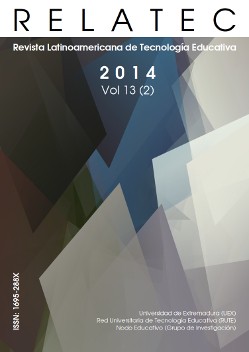Identificação de Perfis de Evasão e Mau Desempenho para Geração de Alertas num Contexto de Educação a Distância / Identifying Evasion and Poor Performance Profiles for the Generation of Alerts in a Distance Learning Context
DOI:
https://doi.org/10.17398/1695-288X.13.2.61Keywords:
Educação à distância, Informática educativa, Inteligência artificial, Abandono escolar, Estatísticas educacionaisAbstract
Este artigo apresenta um estudo sobre o emprego de um sistema que utiliza técnicas de mineração de dados para identificar perfis de evasão e mau desempenho de alunos em um contexto de educação a distância, com o objetivo de alertar professores sobre a situação destes estudantes. Os alertas dão suporte à atuação do professor no acompanhamento dos processos de aprendizagem, com o monitoramento de perfis de alunos e de eventos no ambiente, notificando o professor sobre grupos de alunos que compartilham necessidades específicas. Os resultados de experimentos envolvendo 1780 alunos permitiram concluir que o sistema de alerta proposto pode contribuir com o aumento dos índices de aprovação e redução dos índices de evasão de disciplinas na modalidade à distância. Durante a pesquisa, também foi possível observar que o sistema de alertas contribuiu de maneira significativa na gestão do ambiente virtual de aprendizagem. Muitas das práticas docentes para engajamento dos alunos em seus estudos, bem como de resgate dos estudantes em processo de evasão, foram realizadas a partir do encaminhamento de mensagens aos alunos. A pesquisa mostrou ainda um alto nível de satisfação dos estudantes com relação a estrutura do curso e diálogo/comunicação com o professor. Também foram positivos os resultados quanto à percepção dos estudantes com relação a sua autonomia na realização das atividades do curso.
Abstract
This article presents a study about the use of a system that employs data mining techniques to identify student evasion and poor performance profiles in a distance learning context, with the goal to alert teachers about the situation of these students. The alert system supports the role of the teacher in monitoring the learning process, keeping track of events and notifying teachers about groups of students who share specific needs. Experimental results involving 1780 students showed that the proposed alert system contributed to increase approval rates and reduce dropout rates in distance learning courses. It was also possible to observe that the alert system contributed significantly to the management of the virtual learning environment. Many of the teaching practices to engage students in their studies and rescue them from evading were based on email message exchanges. The research also showed a high level of student satisfaction regarding the course structure and their communication with the teachers. Results were also positive regarding the perception of students with respect to their autonomy in carrying out course activities.
Downloads
Downloads
Published
Issue
Section
License
Authors who publish in this journal accept the following conditions:
1. The Author retains copyright in the article. Upon acceptance of the article, the author shall grant to the Publisher the right of first publication of the article. with the dcoument registered with the Creative Commons Attribution-NonCommercial-NoDerivative 4.0 International (CC BY-NC-ND) license, which allows to third parties to use what is published whenever they mention the authorship of the work and the first publication in this journal.
2. Authors can make other independent and additional contractual agreements for the non-exclusive distribution of the article published in this journal (eg, include it in an institutional repository or publish it in a book) provided they clearly indicate that the work was published for the first time in this journal.
3. Authors are allowed and recommended to publish their work on the Internet (for example on institutional or personal pages) before and during the review and publication process, as it can lead to productive exchanges and a greater and faster diffusion of published work (see The Effect of Open Access).









